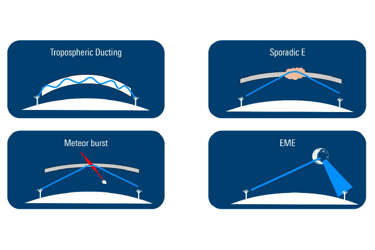Understanding VHF Propagation

Definition of VHF
The International Telecommunications Union (ITU) designates VHF (very high frequency) as frequencies from 30 to 300 MHz. VHF therefore lies directly above HF (high frequency: 3-30 MHz) and directly below UHF (ultra-high frequency: 300-3000 MHz).
These categories are somewhat artificial, and propagation modes do not change abruptly at the edges of these frequency ranges. While there are substantial differences between common propagation modes at HF and VHF, many "VHF” propagation modes often carry signals in the low UHF range as well. Furthermore, propagation can also vary substantially even within the ITU-defined VHF frequency range of 30 to 300 MHz: for example, some modes may only be encountered at the lower end of this frequency range.
Unless otherwise noted, in this educational note "VHF" will be used to refer to signals in the range of approximately 50 to 500 MHz.
Applications of VHF
Signal at VHF are used in a very wide range of applications. Almost all modern radio and television broadcasting takes place at the lower and upper ends of VHF, respectively. Most non-cellular local two-way voice communications are based on VHF. VHF is often used for transferring data, particularly telemetry or other measurement data.
Some of the navigational aids used in aviation, such as Very High Frequency Omni-Directional Range (VOR) and Instrument Landing System (ILS ) also operate at VHF frequencies. In addition, VHF is used for many aerospace and defense applications. For example, several types of radar operate at VHF, such as “antistealth” radars which use longer VHF wavelengths in order to minimize the effectiveness of stealth technology.
Get unlimited access to:
Enter your credentials below to log in. Not yet a member of RF Globalnet? Subscribe today.
